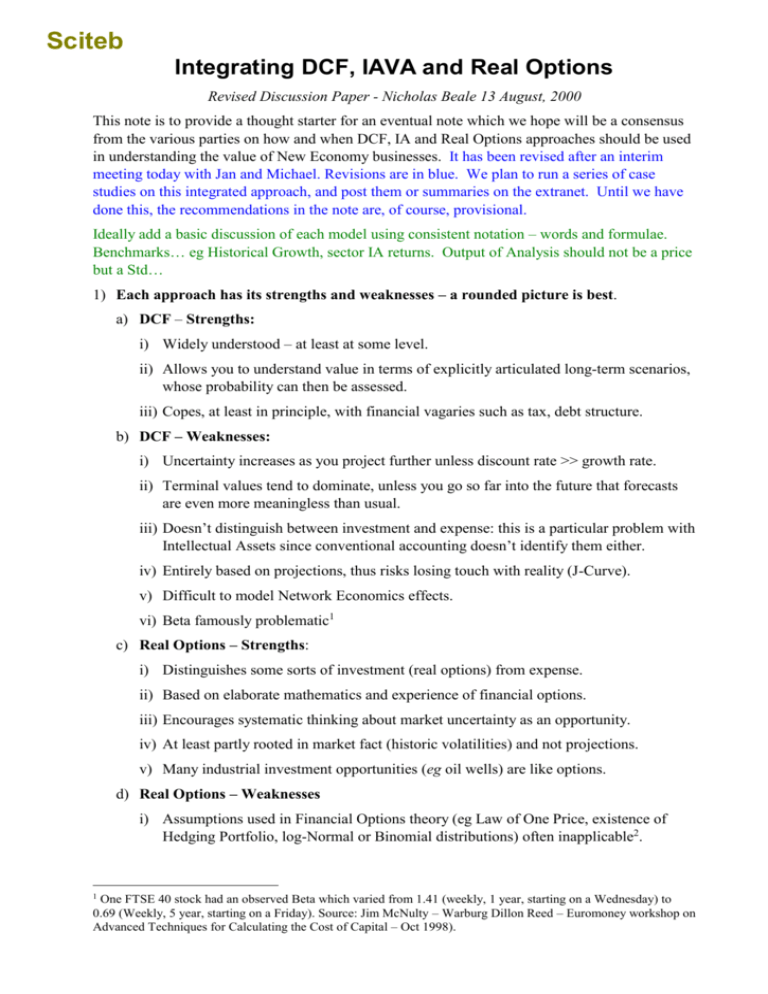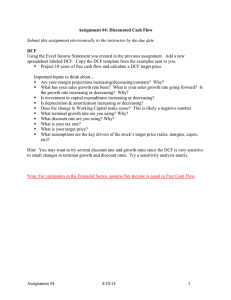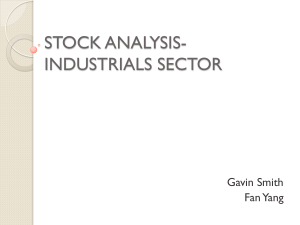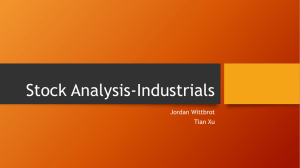revised version
advertisement

Sciteb Integrating DCF, IAVA and Real Options Revised Discussion Paper - Nicholas Beale 13 August, 2000 This note is to provide a thought starter for an eventual note which we hope will be a consensus from the various parties on how and when DCF, IA and Real Options approaches should be used in understanding the value of New Economy businesses. It has been revised after an interim meeting today with Jan and Michael. Revisions are in blue. We plan to run a series of case studies on this integrated approach, and post them or summaries on the extranet. Until we have done this, the recommendations in the note are, of course, provisional. Ideally add a basic discussion of each model using consistent notation – words and formulae. Benchmarks… eg Historical Growth, sector IA returns. Output of Analysis should not be a price but a Std… 1) Each approach has its strengths and weaknesses – a rounded picture is best. a) DCF – Strengths: i) Widely understood – at least at some level. ii) Allows you to understand value in terms of explicitly articulated long-term scenarios, whose probability can then be assessed. iii) Copes, at least in principle, with financial vagaries such as tax, debt structure. b) DCF – Weaknesses: i) Uncertainty increases as you project further unless discount rate >> growth rate. ii) Terminal values tend to dominate, unless you go so far into the future that forecasts are even more meaningless than usual. iii) Doesn’t distinguish between investment and expense: this is a particular problem with Intellectual Assets since conventional accounting doesn’t identify them either. iv) Entirely based on projections, thus risks losing touch with reality (J-Curve). v) Difficult to model Network Economics effects. vi) Beta famously problematic1 c) Real Options – Strengths: i) Distinguishes some sorts of investment (real options) from expense. ii) Based on elaborate mathematics and experience of financial options. iii) Encourages systematic thinking about market uncertainty as an opportunity. iv) At least partly rooted in market fact (historic volatilities) and not projections. v) Many industrial investment opportunities (eg oil wells) are like options. d) Real Options – Weaknesses i) Assumptions used in Financial Options theory (eg Law of One Price, existence of Hedging Portfolio, log-Normal or Binomial distributions) often inapplicable2. 1 One FTSE 40 stock had an observed Beta which varied from 1.41 (weekly, 1 year, starting on a Wednesday) to 0.69 (Weekly, 5 year, starting on a Friday). Source: Jim McNulty – Warburg Dillon Reed – Euromoney workshop on Advanced Techniques for Calculating the Cost of Capital – Oct 1998). ii) Some forms of Intellectual Asset (eg Brands, Skills) are not at all like Options. Also there is important value in the non-Options-like parts of R&D. iii) Outside heavily traded commodities historic performance of financial markets may be highly unreliable guide to ‘true’ future volatilities. And there is something worryingly circular in the idea that Internet Companies are valuable because they have high volatilities, as observed by the volatility of their stocks. iv) Gives valuations for single ‘projects’ viewed as options but difficult to cope with large aggregates especially since the risk profiles of different ‘real options’ in a typical company's portfolio of Intellectual Assets are very strongly correlated. v) Difficult to benchmark performance against competitors and comparators. vi) Often difficult to know what the relevant dimensions of volatility are and how they correlate. vii) Actually excercising a real option often requires substantial investment, new IA and management skills. This tends to be ignored in the maths. e) IAVA – Strengths i) Focuses explicitly on Intellectual Assets and the returns achieved with them. ii) Forces valuations to consider historic and projected performance together. iii) Forces valuations to consider ‘amortization’ of IA – eg Customer Churn Rates, Technological Obsolescence. iv) Easy to benchmark performance against competitors and comparators. v) Offers solution to Terminal Value Problem which provides reality check to DCF Scenarios. vi) Offers framework for analysing Network Economics. f) IAVA – Weaknesses i) Not widely understood or used (yet). ii) Ignores tax, financing and cash timing issues (at present). iii) Terminal Values depend on assets held at end point plus estimates of growth and fade which are (like the future) fairly uncertain. iv) Sometimes needs stochastic or Real Options extensions to deal with uncertainty. 2) Ideally we’d seek a fully integrated conceptual model. The RO model reduces to the DCF model when the volatility is zero, and the IA model reduces to DCF when there are no IA. a) Thus we could envisage an equation: NPV(X) = NPV (CFX) + NPV (TTNFAX) + NPV (TIAX) + NPV(PTIAX) + NPV(TOCX) where TTNFA TIA 2 = Terminal Tangible and Net Financial Assets = Terminal Intellectual Assets At an initial dialogue between the Physicists and the Economists at the Santa Fe Institute, the Economists explained some of their basic assumptions to the Physicists and responded to their objection that these assumptions were unlikely to be valid with “yes, but we need them to make the maths work”. The LTCM fiasco was a hard lesson that the assumptions of options theory do not always apply even in financial markets. And the whole point of being in business is to make an ‘arbitrage profit’ between your inputs and outputs. Thus if there is a significant business opportunity, the fundamental assumption of Real Options theory does not apply: and if the opportunity is not significant, then it is questionable whether it is worth including it in the analysis. PTIA TOC = Post-Terminal IA – ie IA created after the terminal time = Terminal Options Correction b) The concept of a Terminal Options Correction is needed because both Tangible and Intellectual Assets may contain implicit or explicit options already that correlate in a significant way. For example a company (XCo) may have a significant R&D programme in technology X and a minority stake in a start-up (YCo) developing technology Y with an option to purchase the rest. The value of that option is not, (pace Amram et al) dependent on the volatility of YCo’s stock but on the extent to which technology Y is likely to be valuable to company X in the event that technology Y is successful3. c) However in most practical cases the use of scenarios over DCF and IA models is likely to be sufficient, and Real Options analysis should only be used when it adds value. 3) A possible recommended approach to understanding New Economy Valuations could then be as follows: a) Make an explicit forecast scenario for the company in question, over a period where you think forecasting is pretty reasonable. Consider profits, cashflow, tangible assets and IA. b) Look at the IA implications of that forecast – consider whether they are reasonable: whether the patterns of projected return on IA (RoCIA) are plausible. If not, refine the forecast. You should consider the IA behaviour of the company for a reasonable period before the forecast begins, and may wish to consider the IA performance of other comparable companies. You should also explicitly consider whether there are any important Network Economics effects and model them in the IA model if there are. c) Consider whether the final RoCIA and Amortization of IA – or some other figure – are reasonable estimates of the average RoCIA and Amortization over the lifetime of the IA at the end of the forecast period. Use these to derive a Terminal Value for the IA. Consider whether there are any special factors (such as unusual relationships between cashflow and profit) which require an adjustment4. d) Consider whether the book value of the Terminal Tangible and Net Financial Assets needs any adjustment for a realistic Terminal Value5. If so, make it. In particular, some ‘new economy’ businesses have Tangible Assets (such as installed fiber) whose economic rent is far from being historic cost times a cost of capital. e) Consider whether there are any significant Real or Financial Options in the assets (or liabilities) of the business that require a Terminal Options Correction (TOC). This will be the case if the net effect of volatility in a particular dimension is significant (for example, if there is an oilfield and a hedging option on crude then there may be no net volatility). If so, then consider the principal dimensions of volatility that drive the option value and estimate (with due caution) the appropriate Terminal Options Correction to the implied Terminal Values of the relevant set of assets. Use the maths with caution – unless there is a sufficiently liquid market with underlying traded securities and no reason to be very concerned about extreme values the formulae may not be appropriate. See my note on IA and Network Economics for more on this – in progress at present I’m afraid but I’ll post a working draft on the extranet site at ia_network.doc. 3 Usually this will be taken care of by the ‘rent’ on working capital, but some industries and accounting systems book profits long before it would be ‘prudent’ to do so and suitable adjustments may need to be made. There can also be tax implications, although most regimes tax IA hardly at all. 4 5 This may be due eg to accounting conventions that value buildings at cost, even in areas where there has been a large increase in property values. f) Consider what you have to believe about the IA in order to justify the DCF Terminal Values and vice versa. g) Iterate the above for a number of other scenarios. h) Assess their overall probability and derive an expected value.










